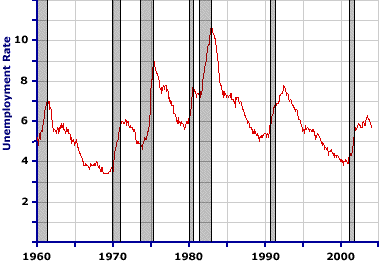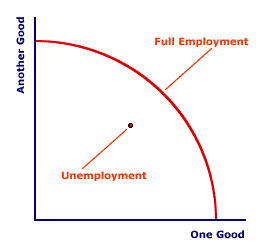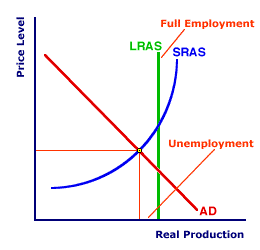
|
|
CHAEBOL: A form of business structure common in South Korean which involves an alliance of businesses, each working toward the mutual success of the group. The alliance also has close ties to government. This is comparable to the keiretsu, which is common in Japan. Each "independent" business owns stock in the others and shares executives and directors.
Visit the GLOSS*arama
|
|


|

|
                           UNEMPLOYMENT: The general condition in which resources are willing and able to produce goods and services but are not engaged in productive activities. While unemployment is most commonly thought of in terms of labor, any of the other factors of production (capital, land, and entrepreneurship) can be unemployed. The analysis of unemployment, especially labor unemployment, goes hand-in-hand with the study of macroeconomics that emerged from the Great Depression of the 1930s. The most common measure of unemployment is the unemployment rate of labor. Unemployment is one of two primary macroeconomic problems. The other is inflation. Unemployment arises when scarce resources that COULD be used to produce goods and services, resources that are WILLING and ABLE to engage in production, are NOT producing output. While the economy always have some degree of unemployment, it tends to become most severe and hence most problematic during a business-cycle contraction.Historical Numbers| Unemployment Rate |  |
As indicated in the exhibit to the right, the unemployment of labor, measured by the unemployment rate, varies over time, especially over the course of business-cycle activity, rising during contractions and falling during expansions. The range is usually between 4 percent and 6 percent, but it has been as low as 2 percent and as high as 25 percent. During the contraction of the early 1990s, the unemployment rate rose from 5 percent to nearly 7 percent. In the ensuring expansion that occupied the better part of the 1990s, the unemployment rate fell from the 7 percent level to just over 4 percent. During the contraction of the early 2000s, it rose from 4 percent to over 6 percent.While the unemployment rate reaches relatively low levels during expansions, it never falls to 0 percent. In principle, full employment is thought of as occurring when ALL resources (especially labor) are engaged in production, in practice, full employment generally corresponds to an unemployment rate of about 5 percent. This 5 percent unemployment rate, often termed the natural unemployment rate, includes both frictional and structural unemployment. Why Study?Unemployment, especially labor, is a key macroeconomic issue that has concerned economists since at least the Great Depression (another key issue is inflation). The devastating economic conditions of the 1930s, which at its depth saw one out of four workers unemployed, brought to the forefront the problems of unemployment. Two in particular that stand out are personal hardships and lost production.- First, unemployment creates personal hardships for the owners of the unemployed resources. When resources do not produce goods, their owners do not earn income. The loss of income results in less consumption and a lower living standard. While this problem applies to any of the resources, it is most important for labor. The owners of capital, land, and entrepreneurship often earn income from more than one resource. Many workers, however, often earn income only from labor.
- Second, unemployment causes total production in the economy to decline. If fewer resources are engaged in production, fewer goods and services are produced. As suggested by the circular flow model, the severity of the connection between lost production and unemployment is magnified by the multiplier effect. An initial decline in income, consumption, and production associated with unemployment triggers further declines in income, consumption, and production. As such, members of society escaping the direct, immediate personal hardships of unemployment can succumb to the indirect, multiplicative problems of lost production.
A Graph or Two| Production Possibilities |  | Aggregate Market |  |
Unemployment can be illustrated with two common economic models--production possibilities and the aggregate market (or AS-AD analysis). Both graphical models are presented in the exhibit to the right.MeasuresKeeping track of unemployed resources is not as easy as it might seem. Unemployed labor is relatively easy to track by simply "counting heads." However, even this head counting is not without problems. Capital is such a diverse resource that no single measure can ever hope to capture the full extent of unemployment. Land, especially the vast types of natural resources associated with the land, encounter similar problems. And entrepreneurship is such a nebulous resource (a worker today, might be an entrepreneur tomorrow, then once again a worker the next day) that just identifying entrepreneurship is extremely difficult, let alone determining its unemployment.However, attempts to measure unemployment of various resources is pursued. Three common unemployment measures are: unemployment rate, capacity utilization rate, and vacancy (or occupancy) rate. - Unemployment Rate: The most noted and widely used measure of resource unemployment is the unemployment rate of labor. In fact, its widespread used is the reason that most people associate unemployment ONLY with labor. The unemployment rate is the percent of the labor force that is officially unemployed. This rate is reported monthly by the Bureau of Labor Statistics of the U.S. Department of Labor, and it is clearly the popular choice when it comes to measuring business-cycle instability.
- Capacity Utilization Rate: A somewhat lesser known indicator is the capacity utilization rate for the measurement of capital unemployment. This is actually a measure of capital employment, but it provides a great deal of insight into the unemployment of capital. Specifically, the capacity utilization rate is the ratio of actual production undertaken by factories to potential production. If the capacity utilization rate is up, then the unemployment of capital (at least the factory variety of capital) is down.
- Vacancy Rate: A popular measure for the real estate industry that also tends to get little notoriety in the rest of the world is the vacancy rate for buildings. It measures the percent of available buildings (office building, apartments, etc.) that are vacant and thus have unemployed capital (rooms). A complementary measure is the occupancy rate, which (like the capacity utilization rate) measures the extend to which buildings are used.
SourcesA modern complex economy like that in the United States does not have just one type of unemployment. Four basic sources or reasons for resource unemployment exist: cyclical, seasonal, frictional, and structural. Once again, while these apply to all four factors of production, they tend to be most important for labor.- Cyclical Unemployment: This is unemployment attributable to a general decline in macroeconomic activity occurring during a business-cycle contraction (or recession). When aggregate demand declines, less aggregate production is sold, so fewer resources are needed. Because cyclical unemployment is considered an avoidable source of unemployment, its reduction or elimination of has been one of the primary goals of macroeconomic policy since the Great Depression.
- Seasonal Unemployment: This is unemployment caused by relatively regular and predictable declines in particular industries or occupations over the course of a year, often corresponding with the seasons. Many construction workers face unemployment during winter months. School teachers face unemployment during the summer months. The employment of farm workers varies with seasonal planting and harvesting activities. Because seasonal unemployment is regular and predictable, it is generally considered part of the "conditions of employment," and is largely ignored in the study of the macroeconomy.
- Frictional Unemployment: This is unemployment that results because resources are in the process of moving from one production activity to another. Frictional unemployment occurs because it takes time to move between production activities. The time needed to match up resources with production depends on information availability and the degree of geographic separation. A carpenter is frictionally unemployed even though a construction company has a job for a carpenter because neither knows about the other. Or perhaps the carpenter lives in North Dakota and the construction company is in North Carolina. In either case, the carpenter remains frictionally unemployed until matching up with the job. And this matching up just takes time.
- Structural Unemployment: This is unemployment occurring because resources do not have the technological configuration, skills, or training required by production activity. For example, the construction company in North Carolina needs a carpenter, but the only available unemployed worker is a plumber. If the only jobs available to the plumber are in carpentry, then the plumber is structurally unemployed.
The key to frictional and structural unemployment, especially for labor, is that the number of jobs available is the same as the number of workers. In other words, the quantity demanded equals the quantity supplied. The problem is that the workers and the jobs do not match up. Either information is lacking or skills are incompatible. Because both frictional and structural unemployment are an inherent part of any complex economy, they are often referred to as natural unemployment. The economy always has some degree of frictional and structural unemployment. In fact, having some degree of frictional and structural unemployment is not necessarily a bad thing. Whether frictional and structural unemployment are good or bad, when combined they form the basis for a key benchmark for macroeconomic policy analysis termed the natural unemployment rate. Because the natural unemployment rate can be sustained with no changes in inflation, it provides an excellent target for macroeconomic policy. PoliciesGiven that people would rather NOT have unemployment and that it tends to increase from time to time, an assortment of government policies have been devised to reduce unemployment. The most noted, fiscal policy and monetary policy, fall under the general heading of stabilization policies that are designed to stabilize business-cycle fluctuations and in so doing lessen the problems of both unemployment and inflation.- Fiscal Policy: Fiscal policy is the discretionary use of government spending and taxes to affect business-cycle fluctuations. The recommended fiscal policy for reducing unemployment is to increase government spending and/or to decrease taxes. When undertaken by the federal government, either or both of these actions lead to an increase in the federal deficit or a decrease in the federal surplus. This goes by the specific name expansionary fiscal policy.
- Monetary Policy: Monetary policy is the discretionary use of the money supply and interest rates to affect business-cycle fluctuations. The recommended monetary policy for reducing unemployment is to increase the money supply and to decrease interest rates. This goes by the specific name expansionary monetary policy.

Recommended Citation:UNEMPLOYMENT, AmosWEB Encyclonomic WEB*pedia, http://www.AmosWEB.com, AmosWEB LLC, 2000-2025. [Accessed: June 30, 2025].
Check Out These Related Terms... | | | | | | | | | |
Or For A Little Background... | | | | | | | | | |
And For Further Study... | | | | | | | | | | | | |
Related Websites (Will Open in New Window)... | | |
Search Again?
Back to the WEB*pedia
|



|

|
PURPLE SMARPHIN
[What's This?]
Today, you are likely to spend a great deal of time searching for rummage sales seeking to buy either a birthday greeting card for your mother that doesn't look like a greeting card or a handcrafted spice rack. Be on the lookout for vindictive digital clocks with revenge on their minds.
Your Complete Scope
This isn't me! What am I?
|

|
|
The 1909 Lincoln penny was the first U.S. coin with the likeness of a U.S. President.
|

|
|
"I learned about the strength you can get from a close family life. I learned to keep going, even in bad times. I learned not to despair, even when my world was falling apart. I learned that there are no free lunches. And I learned the value of hard work. " -- Lee Iacocca
|

|
IPUMS
Integrated Public Use Microdata Series
|

|
|
Tell us what you think about AmosWEB. Like what you see? Have suggestions for improvements? Let us know. Click the User Feedback link.
User Feedback
|


|


